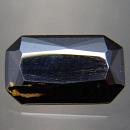|
|
||||||||||||||||
|
||||||||||||||||
|
||||||
|
|
|
|
Euxenite-(Y)
|
|
| | |
| Discovered in 1870; IMA status: Valid (pre-IMA; Grandfathered) | ||
|
| ||
|
Chemistry |
|
|
| |
|
(Y,Ca,Ce,U,Th)(Nb,Ta,Ti)2O6 | |
|
|
Yttrium Calcium Cerium Niobium Tantalum Titanium Oxide |
|
Molecular Weight: |
392.28 gm |
|
Composition: |
Calcium |
2.04 % |
Ca |
2.86 % |
CaO |
|
|
Cerium |
3.57 % |
Ce |
4.18 % |
Ce2O3 |
|
|
Yttrium |
15.86 % |
Y |
20.15 % |
Y2O3 |
|
|
Tantalum |
18.45 % |
Ta |
22.53 % |
Ta2O5 |
|
|
Titanium |
2.44 % |
Ti |
4.07 % |
TiO2 |
|
|
Niobium |
33.16 % |
Nb |
47.43 % |
Nb2O5 |
|
|
Oxygen |
24.47 % |
O |
|
|
|
|
|
100.00 % |
|
100.00 % |
= TOTAL OXIDE |
|
|
|
||||
|
Classification |
|
|
| |
|
Oxides | |
|
4/D.14-20 | |
|
|
4 : OXIDES (Hydroxides, V[5,6] vanadates, arsenites, antimonites, bismuthites, sulfites, selenites, tellurites, iodates)
|
|
Related to: |
Polycrase Group |
|
Varieties: |
None |
|
Synonyms: |
Euxenite, Guimaraesite (of Gagarin & Cuomo), Lyndochite |
|
|
|
|
Crystal Data |
|
|
|
|
|
Orthorhombic - Dipyramidal (Metamict - mineral originally crystalline, now amorphous due to radiation damage) |
|
|
As stout prismatic crystals, to 10 cm, may be flattened || [100] or [010]; commonly in parallel, subparallel, or radiating aggregates; compact massive. |
|
|
Common on {201}; rare on {101} or {013} |
|
|
|
|
|
Physical Properties |
|
|
|
|
|
None |
|
|
Conchoidal to Sub-Conchoidal |
|
|
Brittle |
|
|
5.5 - 6.5 |
|
|
5.30 - 5.90 (g/cm3) |
|
|
None |
|
|
Mild; GRapi = 3,420.62 (Gamma Ray American Petroleum Institute Units) |
|
|
|
|
|
Optical Properties |
|
|
|
|
|
Black, Brownish Black, Greenish Black; Brown to Yellow-Brown in transmitted light |
|
|
Opaque, Translucent on thin edges |
|
|
Vitreous to Sub-Metallic, Waxy to Resinous on fractures |
|
|
2.06 - 2.24 Isotropic; R1–R2: (470) 13.7–15.6, (546) 13.0–15.6, (589) 12.5–15.0, (650) 12.4–15.0 |
|
|
0.000 Isotropic |
|
|
None |
|
|
|
|
|
Occurances |
|
|
|
|
|
Geological Setting: |
From granite pegmatites; as a component of detrital black sands |
|
Common Associations: |
Aeschynite-(Y), Albite, Allanite, Betafite, Beryl, Biotite, Columbite, Gadolinite, Garnet, Ilmenite, Magnetite, Microcline, Monazite, Muscovite, Thorite, Uraninite, Xenotime, Zircon |
|
Type Locality: |
Jølster, Sunnfjord, Sogn og Fjordane, Norway |
|
Year Discovered: |
1870 |
|
View mineral photos: | |
|
|
|
|
More Information |
|
|
|
|
|
| |
|
|
|
|
There
are numerous
Euxenite localities worldwide. In Norway, from Jölster, Söndfjord;
at Alve, on Tromö Island; on Hidra (Hitterö) Island,
near Flekkefjord; at many other places between Tvedestrand
and Arendal, and in Iveland and Evje Parishes, Sätersdal.
In Sweden, in the Ruoutevare Fe–Ti deposit, near Kvikkjokk,
Norrbotten; at Ytterby, on Resarö Island, near Vaxholm;
and elsewhere. From Huntila, Pitkäranta district, Lake
Ladoga, Karelia, Russia. In Madagascar, large crystals
from Vohimasina; Ambatofotsikely; Ankazobe, near Ambohitantely;
Ambolotara; Ranomafana; and elsewhere. In Brazil, from
Santa Clara, Pomba, and Espirito Santo, Minas Gerais.
In Canada, from Lyndoch, Sabine, and Mattawan Townships,
and elsewhere in Ontario; also in Quebec. In the USA,
from the Rutherford pegmatite, Amelia County, the Nanco
pegmatite, Bedford County, and others in Virginia; from
Morton, Delaware County, Pennsylvania; at Encampment, Carbon
County, Wyoming; from Guffey, Park County, near Bergen Park,
Jefferson County, and the Colorado feldspar pegmatite,
Fremont County, Colorado. |
|
|
We
have not photographed our Euxenite gems. Please
check back soon. |
